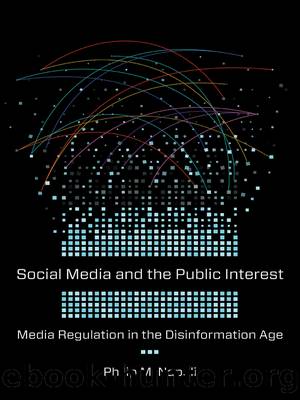Social Media and the Public Interest by Philip M. Napoli

Author:Philip M. Napoli
Language: eng
Format: epub
Tags: LAN008000, Language Arts & Disciplines/Journalism, SOC052000, Social Science/Media Studies
Publisher: Columbia University Press
Published: 2019-08-27T00:00:00+00:00
Implications
In this chapter, I have made the case that the public-interest principle has been systematically diminished and marginalized within the context of social media governance. These processes of diminishment and marginalization have been a function of the much narrower, technocentric orientations of these technology firms that have taken on the functionality—though not the responsibility—of media organizations. It has also been a function of the technological particularism that has guided the construction of regulatory rationales. However, the problems and concerns being generated by the operation of social media platforms fit squarely within traditional notions of the public interest in media governance.
All of this leads to the question of what happens if the rationales for media regulation, which reflect specific technological contexts out of which they were generated, fail to apply to new technological contexts in which the motivations may be equally compelling. If the accompanying rationales do not translate to these newer technological contexts, then we are ultimately left with a decision to make: what matters more, the motivations for media regulation or the rationales? This question becomes particularly acute when we consider that the regulatory rationales discussed earlier are, for the most part, inapplicable to increasingly dominant and influential social media and search engine platforms, which play an increasingly influential role in the dissemination, consumption, and financial health of the media organizations that utilize the technologies and do fall within these regulatory rationales. In this way, the regulated and the unregulated sectors of the media ecosystem are increasingly intertwined—not unlike, it should be noted, the relationship that served as the catalyst for the “reasonably ancillary” rationale discussed earlier.
In 2011, the Federal Communications Commission conducted an extensive and ambitious proceeding dedicated to the complex topic of whether community information needs were being met in the digital age.98 After producing a massive report on the topic, which illustrated the many threats to informed communities, despite (and, to some extent, because of) the diffusion of digital media, the commission proposed only modest exercises of existing regulatory authority, such as requiring broadcasters to make their public inspection file available online, and called for other institutions, such as foundations, to step in and help solve the problem.99 The underlying message of these proposals was clear: the regulatory rationales that delineate the scope of the FCC’s regulatory authority allowed the agency to, at best, nibble around the edges of a substantial communications policy problem—a problem that strikes at the heart of the effective functioning of the democratic process. In many ways, the outcome of this proceeding is a microcosm of the issue presented in this chapter—that a much-needed, more robust public-interest framework for social media governance has yet to emerge from either the relevant institutions or policy makers.
My discussion of the public-interest principle’s traditional role in media governance is a reminder of how the norms of public service and a commitment to enhancing the democratic process have long been ingrained, and explicitly articulated, in the governance frameworks for traditional news media. However, many would argue that
Download
This site does not store any files on its server. We only index and link to content provided by other sites. Please contact the content providers to delete copyright contents if any and email us, we'll remove relevant links or contents immediately.
The Secret History by Donna Tartt(16626)
The Social Justice Warrior Handbook by Lisa De Pasquale(11489)
Thirteen Reasons Why by Jay Asher(7788)
This Is How You Lose Her by Junot Diaz(5774)
Weapons of Math Destruction by Cathy O'Neil(5037)
Zero to One by Peter Thiel(4824)
The Myth of the Strong Leader by Archie Brown(4789)
Promise Me, Dad by Joe Biden(4449)
Beartown by Fredrik Backman(4419)
Stone's Rules by Roger Stone(4416)
How Democracies Die by Steven Levitsky & Daniel Ziblatt(4399)
The Fire Next Time by James Baldwin(4343)
100 Deadly Skills by Clint Emerson(4079)
A Higher Loyalty: Truth, Lies, and Leadership by James Comey(4033)
Rise and Kill First by Ronen Bergman(4012)
The David Icke Guide to the Global Conspiracy (and how to end it) by David Icke(3883)
The Farm by Tom Rob Smith(3872)
Secrecy World by Jake Bernstein(3783)
The Doomsday Machine by Daniel Ellsberg(3731)
